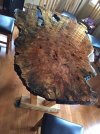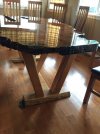- Joined
- Apr 17, 2018
- Messages
- 319
I use colored epoxy to fill in voids in some of my burl wood. I find tiny little air bubbles in it and I never get a smooth surface when I'm done. I know that you can use a quick shot of heat from a torch to get bubbles out of a por,,,,, but not sure if epoxy is the same stuff. Hep!!!



